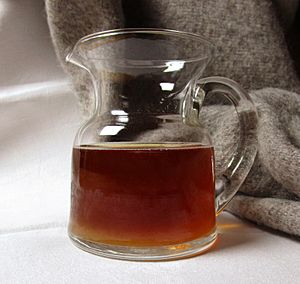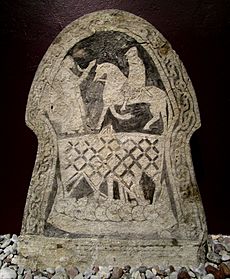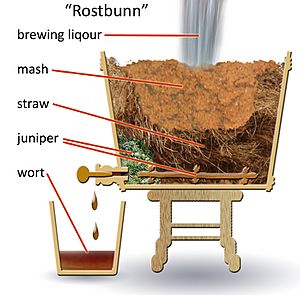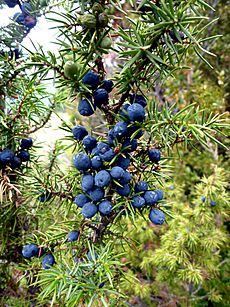Gotlandsdricka facts for kids
Gotlandsdricka (pronounced "GOT-lands-drick-ah") is a special traditional drink from the island of Gotland, Sweden. It's a type of homemade ale, similar to drinks found in Finland and Norway. It has a unique smoky, bitter-sweet, and spicy taste, often with a strong flavor of juniper.
This drink is very much like what people drank during the Viking Age in Nordic countries. For a long time, only women on Gotland traditionally made drikke.
It's hard to make drikke for big stores, so it has become a special symbol for the people of Gotland. Every autumn, there's even a world championship for brewing drikke on the island.
Contents
What is Gotlandsdricka?
Drikke is a traditional, homemade, and fermented alcoholic drink from Gotland, an island in the Baltic Sea. It is not filtered or pasteurized.
The main things used to make it are juniper branches, malt, hops, yeast, water, and sugar. It tastes smoky, bitter-sweet, and full-bodied, with a clear juniper flavor. The drink is usually dark yellow to golden brown, sometimes with a pink color, and looks a bit cloudy.
People usually drink drikke when it is still young and fermenting. It takes about a week to ferment and should be enjoyed within two weeks after that. After this time, the taste usually gets worse. The amount of alcohol in drikke can be from 3% to 12%, but it is usually around 4-5%. This depends on how much sugar is added.
History of Gotlandsdricka
The name gotlandsdricka simply means "Gotlandic drink." People from Gotland like to show that drikke is different from regular ale or beer.
In the past, drikke was often served with meals, much like milk or water today. Before modern factories, these drinks were made from malt, juniper, birch sap, and honey. The drink made from juniper was seen as a drink for poorer people. Malt drinks were considered the best and were served at special events. Today, only svagdricka and gotlandsdricka are still commonly used with meals.
From the Viking Age until the Industrial Revolution, brewing ale and drikke on Gotland was a job mainly for women. Men might help by getting water, wood, or juniper, but the actual brewing was done by women. A farm's reputation often depended on how good its brews were for workers and guests. The woman of the house took great pride in her brewing skills.
Gotlandsdricka is very much like the everyday drink that Vikings enjoyed. Even though brewing methods have changed over time, the ingredients and taste are still similar. This type of drink was once made in all Nordic countries. However, the tradition of brewing it has mostly survived in smaller, more isolated places, like Gotland.
When hops came to Scandinavia in the 13th century, they were added to drikke for flavor alongside juniper. Gotland kept the tradition of using juniper, but some hops were added because they helped preserve the drink and added more taste. The main flavors still came from juniper branches and sweet gale. In the 20th century, sugar began to replace honey as the sweetener. However, some parts of the island still brew it with honey, or without any extra sweetener at all. Gotlandsdricka is very similar to the Finnish sahti and Norwegian kornøl, which use similar ingredients and methods.
How Gotlandsdricka is Made
The process of making gotlandsdricka starts by turning grain into malt. Grains like barley, wheat, rye, or oats can be used, depending on what is grown nearby. Malt is made by letting the grain sprout and then drying it.
On Gotland, the drying is often done in a farm's sauna house or a small, special hut called a kölna. This hut is usually built on top of the brewing house. Most malt is dried in smoke from a fire below the kölna. Some farms use pipes to circulate hot air under the malt to make the drikke less smoky. There are many ways to use wood for drying, and whether to use wood with or without bark. The kölna could also be used for drying flax or for smoking meat, fish, or other foods. After drying, the malt is ground. People have different ideas about how fine the ground malt should be.
Next, the ground malt is put into a wooden mash tun. Hot brewing liquid, made from water boiled with juniper branches and berries, is poured into the tun. This thick mixture, called mash, is stirred well and then left to sit for a few hours.
Brewing happens in a wooden tub called a rostbunn, which has a tap at the bottom. Inside the rostbunn, different layers of brewing ingredients are carefully placed. This is called "laying the bunn." Getting the bunn just right is the hardest and most important part of brewing. The layers must be packed enough for the liquid to flow slowly, but not so tight that it stops completely.
There are many traditions for "laying the bunn", some with old beliefs. For example, people often work in complete silence, and no "outsiders" are allowed to be there. Sometimes, a piece of steel or an old stone axe is placed in the bunn. A layer of shaved juniper branches is put at the bottom of the rostbunn. The area near the tap is padded with juniper branches. Then, the tub is lined with straw (or thinner juniper branches), and the mash is placed in the middle.
Once the bunn is ready, more hot brewing liquid is poured onto the mash. The tap is carefully opened. The liquid, called wort, or lännu, is collected in a bucket. More brewing liquid can be added to the bunn as needed, depending on how strong the lännu should be. Sometimes, the first lännu is kept separate as a stronger drink for special times. The collected lännu is then boiled. The longer it boils, the sweeter the drikke will be. Extra flavors like hops or sweet gale, and sugar or honey, are added during this step.
Finally, the brew is cooled and filtered. Yeast, usually regular baking yeast, is added. The drikke is then put into wooden barrels or glass carboys to ferment for four or five days. Some modern brewers have tried bottling drikke before it finishes fermenting. This makes it fizzy and sparkling.
Modern Brewing
Today, many brewers use modern tools instead of old wooden ones. They might use tubs and buckets made of steel or plastic. Malt is often bought from breweries. The whole process can be made shorter by boiling a bag with malt, hops, and other spices directly in the brewing liquid in a large pot on a stove. Fermenting is often done in plastic jerrycans.
Commercial Challenges
When the annual Medieval Week on Gotland started in 1984, drikke was made and sold at the medieval market. In 2000, this caught the attention of authorities in Sweden. The police stopped the sales. A main problem was that the alcohol content in the brew was not always the same. Another issue was that drikke spoils quickly. It cannot be made and bottled in ways that meet the rules of the National Food Administration. This also meant drikke could not be served at events when Gotland was chosen as Sweden's "Food Capital" in 2013. Several attempts have been made to allow it to be sold or served at public events, but these have all been turned down.
In 2012, the Gute vingård (Gute Vineyard) created the first commercial whisky made from gotlandsdricka. It was called "Gutevin Sudret Whiskey." The first batch was put into barrels in 2004 and aged until 2013.
A version of Gotlandsdricka is also brewed at the Jester King Brewery in Texas and at Niagara College in Canada.
A Cultural Symbol
In the early 1900s, when the northern part of Gotland became more industrial, local traditions changed. Homebrewing was mostly stopped, and the art of making drikke became less common, mainly staying in the southern part of the island.
In the late 1960s, interest in malt-brewing came back. This was part of a trend across Sweden to rediscover old traditions and crafts. Gotland also became a popular place for tourists. Traditional Gotlandic culture and crafts, like drikke, became a way for people on the island to keep their own identity.
The drikke is an excellent excuse for Gotlanders to snub rich visitors from the mainland. It is positively loaded and virtually inaccessible to the visitor, and it exudes a whiff of the past, leading one's thoughts to the island's former days of glory.
Competition
The drikke brewing world championship has been held every year since 1991. It usually takes place in the southern part of the island. Anyone who brews gotlandsdricka can enter the competition. A jury of six people usually judges 35-40 entries. As of 2015, the youngest winner was Daniel Lundström, who was 22 years old in 2014.
In 2008, the German TV station ProSieben filmed the championship for their show "Galileo." The show featured traditional Gotlandic food, like cooked lamb eyes and lamb skulls, served with drikke.
See also
 In Spanish: Gotlandsdricka para niños
In Spanish: Gotlandsdricka para niños





